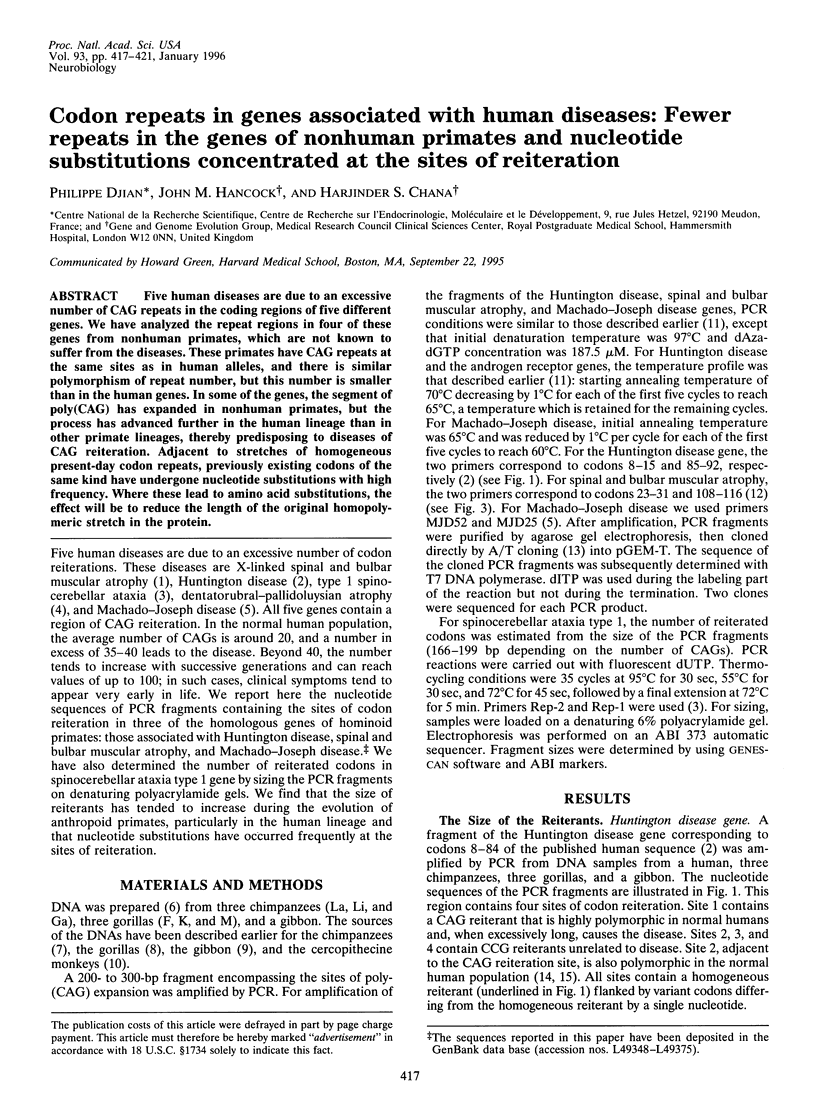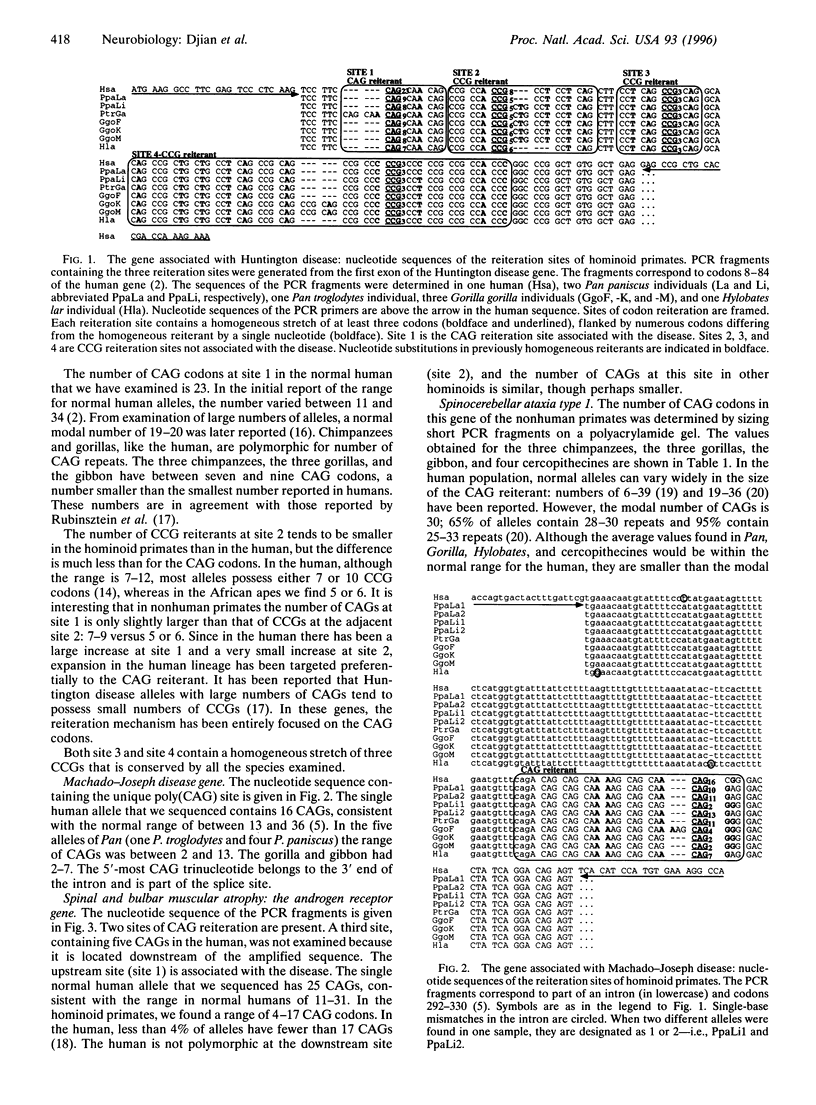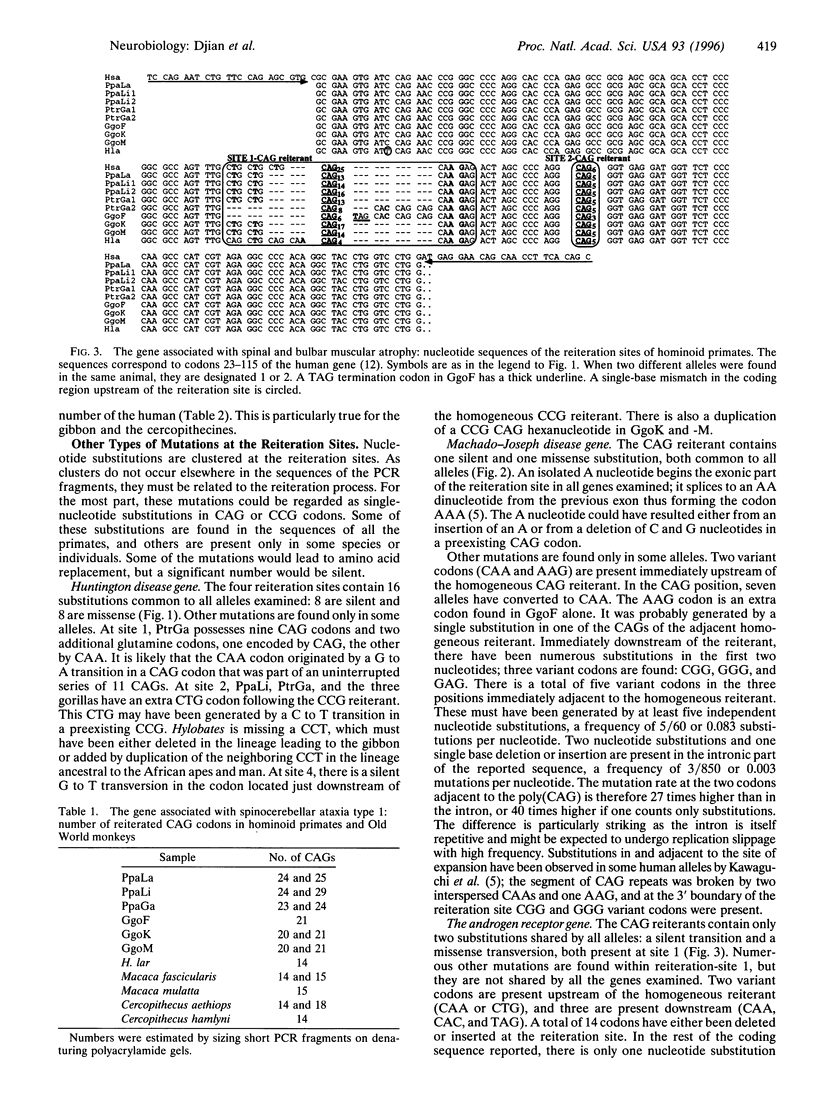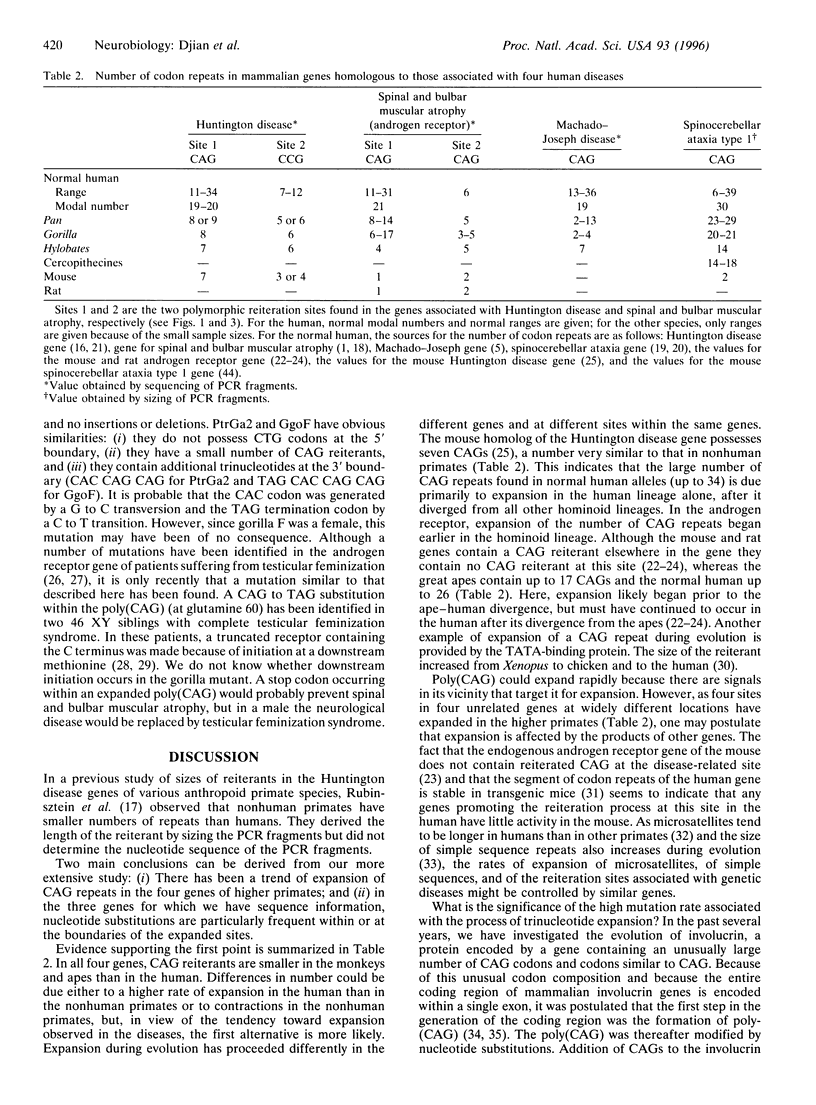Abstract
Five human diseases are due to an excessive number of CAG repeats in the coding regions of five different genes. We have analyzed the repeat regions in four of these genes from nonhuman primates, which are not known to suffer from the diseases. These primates have CAG repeats at the same sites as in human alleles, and there is similar polymorphism of repeat number, but this number is smaller than in the human genes. In some of the genes, the segment of poly(CAG) has expanded in nonhuman primates, but the process has advanced further in the human lineage than in other primate lineages, thereby predisposing to diseases of CAG reiteration. Adjacent to stretches of homogeneous present-day codon repeats, previously existing codons of the same kind have undergone nucleotide substitutions with high frequency. Where these lead to amino acid substitutions, the effect will be to reduce the length of the original homopolymeric stretch in the protein.
Full text
PDF




Selected References
These references are in PubMed. This may not be the complete list of references from this article.
- Andrew S. E., Goldberg Y. P., Theilmann J., Zeisler J., Hayden M. R. A CCG repeat polymorphism adjacent to the CAG repeat in the Huntington disease gene: implications for diagnostic accuracy and predictive testing. Hum Mol Genet. 1994 Jan;3(1):65–67. doi: 10.1093/hmg/3.1.65. [DOI] [PubMed] [Google Scholar]
- Barron L. H., Rae A., Holloway S., Brock D. J., Warner J. P. A single allele from the polymorphic CCG rich sequence immediately 3' to the unstable CAG trinucleotide in the IT15 cDNA shows almost complete disequilibrium with Huntington's disease chromosomes in the Scottish population. Hum Mol Genet. 1994 Jan;3(1):173–175. doi: 10.1093/hmg/3.1.173. [DOI] [PubMed] [Google Scholar]
- Bingham P. M., Scott M. O., Wang S., McPhaul M. J., Wilson E. M., Garbern J. Y., Merry D. E., Fischbeck K. H. Stability of an expanded trinucleotide repeat in the androgen receptor gene in transgenic mice. Nat Genet. 1995 Feb;9(2):191–196. doi: 10.1038/ng0295-191. [DOI] [PubMed] [Google Scholar]
- Burright E. N., Clark H. B., Servadio A., Matilla T., Feddersen R. M., Yunis W. S., Duvick L. A., Zoghbi H. Y., Orr H. T. SCA1 transgenic mice: a model for neurodegeneration caused by an expanded CAG trinucleotide repeat. Cell. 1995 Sep 22;82(6):937–948. doi: 10.1016/0092-8674(95)90273-2. [DOI] [PubMed] [Google Scholar]
- Chang C. S., Kokontis J., Liao S. T. Structural analysis of complementary DNA and amino acid sequences of human and rat androgen receptors. Proc Natl Acad Sci U S A. 1988 Oct;85(19):7211–7215. doi: 10.1073/pnas.85.19.7211. [DOI] [PMC free article] [PubMed] [Google Scholar]
- Chong S. S., McCall A. E., Cota J., Subramony S. H., Orr H. T., Hughes M. R., Zoghbi H. Y. Gametic and somatic tissue-specific heterogeneity of the expanded SCA1 CAG repeat in spinocerebellar ataxia type 1. Nat Genet. 1995 Jul;10(3):344–350. doi: 10.1038/ng0795-344. [DOI] [PubMed] [Google Scholar]
- Djian P., Green H. The involucrin gene of Old-World monkeys and other higher primates: synapomorphies and parallelisms resulting from the same gene-altering mechanism. Mol Biol Evol. 1992 May;9(3):417–432. doi: 10.1093/oxfordjournals.molbev.a040733. [DOI] [PubMed] [Google Scholar]
- Djian P., Green H. The involucrin gene of the gibbon: the middle region shared by the hominoids. Mol Biol Evol. 1990 May;7(3):220–227. doi: 10.1093/oxfordjournals.molbev.a040601. [DOI] [PubMed] [Google Scholar]
- Djian P., Green H. Vectorial expansion of the involucrin gene and the relatedness of the hominoids. Proc Natl Acad Sci U S A. 1989 Nov;86(21):8447–8451. doi: 10.1073/pnas.86.21.8447. [DOI] [PMC free article] [PubMed] [Google Scholar]
- Djian P., Phillips M., Easley K., Huang E., Simon M., Rice R. H., Green H. The involucrin genes of the mouse and the rat: study of their shared repeats. Mol Biol Evol. 1993 Nov;10(6):1136–1149. doi: 10.1093/oxfordjournals.molbev.a040069. [DOI] [PubMed] [Google Scholar]
- Duyao M., Ambrose C., Myers R., Novelletto A., Persichetti F., Frontali M., Folstein S., Ross C., Franz M., Abbott M. Trinucleotide repeat length instability and age of onset in Huntington's disease. Nat Genet. 1993 Aug;4(4):387–392. doi: 10.1038/ng0893-387. [DOI] [PubMed] [Google Scholar]
- Eckert R. L., Green H. Structure and evolution of the human involucrin gene. Cell. 1986 Aug 15;46(4):583–589. doi: 10.1016/0092-8674(86)90884-6. [DOI] [PubMed] [Google Scholar]
- Edwards A., Hammond H. A., Jin L., Caskey C. T., Chakraborty R. Genetic variation at five trimeric and tetrameric tandem repeat loci in four human population groups. Genomics. 1992 Feb;12(2):241–253. doi: 10.1016/0888-7543(92)90371-x. [DOI] [PubMed] [Google Scholar]
- Faber P. W., King A., van Rooij H. C., Brinkmann A. O., de Both N. J., Trapman J. The mouse androgen receptor. Functional analysis of the protein and characterization of the gene. Biochem J. 1991 Aug 15;278(Pt 1):269–278. doi: 10.1042/bj2780269. [DOI] [PMC free article] [PubMed] [Google Scholar]
- Goldberg Y. P., Andrew S. E., Clarke L. A., Hayden M. R. A PCR method for accurate assessment of trinucleotide repeat expansion in Huntington disease. Hum Mol Genet. 1993 Jun;2(6):635–636. doi: 10.1093/hmg/2.6.635. [DOI] [PubMed] [Google Scholar]
- Green H., Djian P. Consecutive actions of different gene-altering mechanisms in the evolution of involucrin. Mol Biol Evol. 1992 Nov;9(6):977–1017. doi: 10.1093/oxfordjournals.molbev.a040775. [DOI] [PubMed] [Google Scholar]
- Green H. Human genetic diseases due to codon reiteration: relationship to an evolutionary mechanism. Cell. 1993 Sep 24;74(6):955–956. doi: 10.1016/0092-8674(93)90718-6. [DOI] [PubMed] [Google Scholar]
- Green H., Wang N. Codon reiteration and the evolution of proteins. Proc Natl Acad Sci U S A. 1994 May 10;91(10):4298–4302. doi: 10.1073/pnas.91.10.4298. [DOI] [PMC free article] [PubMed] [Google Scholar]
- Hancock J. M. Evolution of sequence repetition and gene duplications in the TATA-binding protein TBP (TFIID). Nucleic Acids Res. 1993 Jun 25;21(12):2823–2830. doi: 10.1093/nar/21.12.2823. [DOI] [PMC free article] [PubMed] [Google Scholar]
- He W. W., Fischer L. M., Sun S., Bilhartz D. L., Zhu X. P., Young C. Y., Kelley D. B., Tindall D. J. Molecular cloning of androgen receptors from divergent species with a polymerase chain reaction technique: complete cDNA sequence of the mouse androgen receptor and isolation of androgen receptor cDNA probes from dog, guinea pig and clawed frog. Biochem Biophys Res Commun. 1990 Sep 14;171(2):697–704. doi: 10.1016/0006-291x(90)91202-4. [DOI] [PubMed] [Google Scholar]
- Kawaguchi Y., Okamoto T., Taniwaki M., Aizawa M., Inoue M., Katayama S., Kawakami H., Nakamura S., Nishimura M., Akiguchi I. CAG expansions in a novel gene for Machado-Joseph disease at chromosome 14q32.1. Nat Genet. 1994 Nov;8(3):221–228. doi: 10.1038/ng1194-221. [DOI] [PubMed] [Google Scholar]
- Koide R., Ikeuchi T., Onodera O., Tanaka H., Igarashi S., Endo K., Takahashi H., Kondo R., Ishikawa A., Hayashi T. Unstable expansion of CAG repeat in hereditary dentatorubral-pallidoluysian atrophy (DRPLA). Nat Genet. 1994 Jan;6(1):9–13. doi: 10.1038/ng0194-9. [DOI] [PubMed] [Google Scholar]
- La Spada A. R., Wilson E. M., Lubahn D. B., Harding A. E., Fischbeck K. H. Androgen receptor gene mutations in X-linked spinal and bulbar muscular atrophy. Nature. 1991 Jul 4;352(6330):77–79. doi: 10.1038/352077a0. [DOI] [PubMed] [Google Scholar]
- Lin B., Nasir J., MacDonald H., Hutchinson G., Graham R. K., Rommens J. M., Hayden M. R. Sequence of the murine Huntington disease gene: evidence for conservation, alternate splicing and polymorphism in a triplet (CCG) repeat [corrected]. Hum Mol Genet. 1994 Jan;3(1):85–92. doi: 10.1093/hmg/3.1.85. [DOI] [PubMed] [Google Scholar]
- Matilla T., Volpini V., Genís D., Rosell J., Corral J., Dávalos A., Molins A., Estivill X. Presymptomatic analysis of spinocerebellar ataxia type 1 (SCA1) via the expansion of the SCA1 CAG-repeat in a large pedigree displaying anticipation and parental male bias. Hum Mol Genet. 1993 Dec;2(12):2123–2128. doi: 10.1093/hmg/2.12.2123. [DOI] [PubMed] [Google Scholar]
- Orr H. T., Chung M. Y., Banfi S., Kwiatkowski T. J., Jr, Servadio A., Beaudet A. L., McCall A. E., Duvick L. A., Ranum L. P., Zoghbi H. Y. Expansion of an unstable trinucleotide CAG repeat in spinocerebellar ataxia type 1. Nat Genet. 1993 Jul;4(3):221–226. doi: 10.1038/ng0793-221. [DOI] [PubMed] [Google Scholar]
- Perutz M. F., Johnson T., Suzuki M., Finch J. T. Glutamine repeats as polar zippers: their possible role in inherited neurodegenerative diseases. Proc Natl Acad Sci U S A. 1994 Jun 7;91(12):5355–5358. doi: 10.1073/pnas.91.12.5355. [DOI] [PMC free article] [PubMed] [Google Scholar]
- Pinsky L., Trifiro M., Kaufman M., Beitel L. K., Mhatre A., Kazemi-Esfarjani P., Sabbaghian N., Lumbroso R., Alvarado C., Vasiliou M. Androgen resistance due to mutation of the androgen receptor. Clin Invest Med. 1992 Oct;15(5):456–472. [PubMed] [Google Scholar]
- Ranum L. P., Chung M. Y., Banfi S., Bryer A., Schut L. J., Ramesar R., Duvick L. A., McCall A., Subramony S. H., Goldfarb L. Molecular and clinical correlations in spinocerebellar ataxia type I: evidence for familial effects on the age at onset. Am J Hum Genet. 1994 Aug;55(2):244–252. [PMC free article] [PubMed] [Google Scholar]
- Rubinsztein D. C., Amos W., Leggo J., Goodburn S., Jain S., Li S. H., Margolis R. L., Ross C. A., Ferguson-Smith M. A. Microsatellite evolution--evidence for directionality and variation in rate between species. Nat Genet. 1995 Jul;10(3):337–343. doi: 10.1038/ng0795-337. [DOI] [PubMed] [Google Scholar]
- Rubinsztein D. C., Amos W., Leggo J., Goodburn S., Ramesar R. S., Old J., Bontrop R., McMahon R., Barton D. E., Ferguson-Smith M. A. Mutational bias provides a model for the evolution of Huntington's disease and predicts a general increase in disease prevalence. Nat Genet. 1994 Aug;7(4):525–530. doi: 10.1038/ng0894-525. [DOI] [PubMed] [Google Scholar]
- Stallings R. L. Distribution of trinucleotide microsatellites in different categories of mammalian genomic sequence: implications for human genetic diseases. Genomics. 1994 May 1;21(1):116–121. doi: 10.1006/geno.1994.1232. [DOI] [PubMed] [Google Scholar]
- Stott K., Blackburn J. M., Butler P. J., Perutz M. Incorporation of glutamine repeats makes protein oligomerize: implications for neurodegenerative diseases. Proc Natl Acad Sci U S A. 1995 Jul 3;92(14):6509–6513. doi: 10.1073/pnas.92.14.6509. [DOI] [PMC free article] [PubMed] [Google Scholar]
- Teumer J., Green H. Divergent evolution of part of the involucrin gene in the hominoids: unique intragenic duplications in the gorilla and human. Proc Natl Acad Sci U S A. 1989 Feb;86(4):1283–1286. doi: 10.1073/pnas.86.4.1283. [DOI] [PMC free article] [PubMed] [Google Scholar]
- Tilley W. D., Marcelli M., Wilson J. D., McPhaul M. J. Characterization and expression of a cDNA encoding the human androgen receptor. Proc Natl Acad Sci U S A. 1989 Jan;86(1):327–331. doi: 10.1073/pnas.86.1.327. [DOI] [PMC free article] [PubMed] [Google Scholar]
- Wilson C. M., McPhaul M. J. A and B forms of the androgen receptor are present in human genital skin fibroblasts. Proc Natl Acad Sci U S A. 1994 Feb 15;91(4):1234–1238. doi: 10.1073/pnas.91.4.1234. [DOI] [PMC free article] [PubMed] [Google Scholar]
- Wilson J. D. Syndromes of androgen resistance. Biol Reprod. 1992 Feb;46(2):168–173. doi: 10.1095/biolreprod46.2.168. [DOI] [PubMed] [Google Scholar]
- Zoppi S., Wilson C. M., Harbison M. D., Griffin J. E., Wilson J. D., McPhaul M. J., Marcelli M. Complete testicular feminization caused by an amino-terminal truncation of the androgen receptor with downstream initiation. J Clin Invest. 1993 Mar;91(3):1105–1112. doi: 10.1172/JCI116269. [DOI] [PMC free article] [PubMed] [Google Scholar]
- Zühlke C., Riess O., Bockel B., Lange H., Thies U. Mitotic stability and meiotic variability of the (CAG)n repeat in the Huntington disease gene. Hum Mol Genet. 1993 Dec;2(12):2063–2067. doi: 10.1093/hmg/2.12.2063. [DOI] [PubMed] [Google Scholar]


